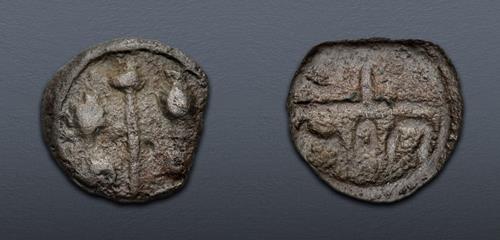
|
Heraclius, with Heraclius Constantine. 610-641. Æ (11mm, 0.86 g, 9h). Unofficial issue. Uncertain Egyptian mint, but likely Panopolis/Antinoopolis. Struck circa 650-circa 690(?). Good Fine.
Electronic Auction 550
Lot: 654. Estimated: $ 100
Byzantine, Bronze
Sold For $ 500. This amount does not include the buyer’s fee.
Go to Live
|
|
Heraclius, with Heraclius Constantine. 610-641. Æ (11mm, 0.86 g, 9h). Unofficial issue. Uncertain Egyptian mint, but likely Panopolis/Antinoopolis. Struck circa 650-circa 690(?). Crowned facing busts of Heraclius and Heraclius Constantine, cross potent between / Large cross; A - ω flanking; (retrograde ΠON). Tony Goodwin, “The Egyptian Arab-Byzantine Coinage” in Oddy et al. Coinage and History in the Seventh Century Near East 4, 2015, Type V; cf. Daniele Castrizio “Le Monete della Necropoli Nord di Antinoupolis (1937-2007) in Instituto Papirologico “G. Vitelli,” Scavi e Materiali Vol. II Firenze, 2010; DOC –; cf. MIB pl. 16, X48; BMC 321; BN 82-3; SB –. Rough brown patina. Good Fine. Rare.
From an interesting series. Discussed back in Josef Wilhelm Kubitschek’s article “Beiträge zur Frühbyzantinischen Numismatik” for the 1897 NZ, it was there that the theory of the mint mark standing for Panopolis was suggested. His hypothesis was that Panopolis operated as a substitute mint in Egypt following the occupation of Alexandria by Sasanian forces from 618-628. Both Wroth in BMC and Morrisson in BN include the series which is largely absent from the older primary references (though Hahn does mention the series in his plates under Egyptian imitations). Wroth noted at the time that most of the coins of this issue feature small and thin flans incompatible with the Alexandrian mint. He echoed Kubitschek’s suggestion but neither endorsed nor rejected it. Morrisson alternatively suggested that they belonged to an unofficial series struck contemporary to the later Arab conquest of Egypt which began circa 639-642.
However, this series is now better understood from recent scholarship. Most recently, Tony Goodwin treated the series in his 2021 article following the new find published in Castrizio 2010. Castrizio detailed a major find of the series which lent substantial credence to the issue originating near Panopolis/Antinoopolis. As far as the dating of the issue is concerned, Goodwin explains in his article that “For the moment the date range for Types I, V and VI remains uncertain, although it seems reasonable to assume that they are all earlier than the “crossless” types. So the date range must remain as wide as c. 650-690, although it is highly unlikely that any of these types was struck for a period of more than 20 years.” Finally, the issue was also covered by David Woods who offered an additional suggestion for the series in an article for volume 13 of the 2018 INR.
Closing Date and Time: 15 November 2023 at 13:37:40 ET.
All winning bids are subject to a 20% buyer’s fee.
|
